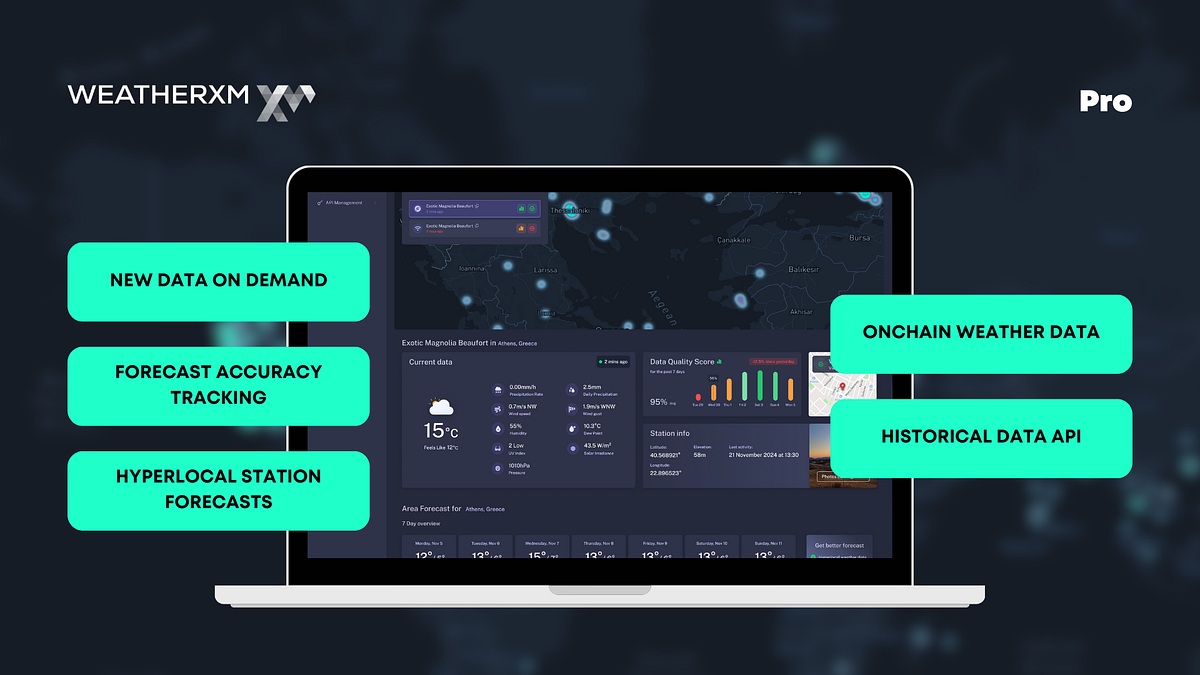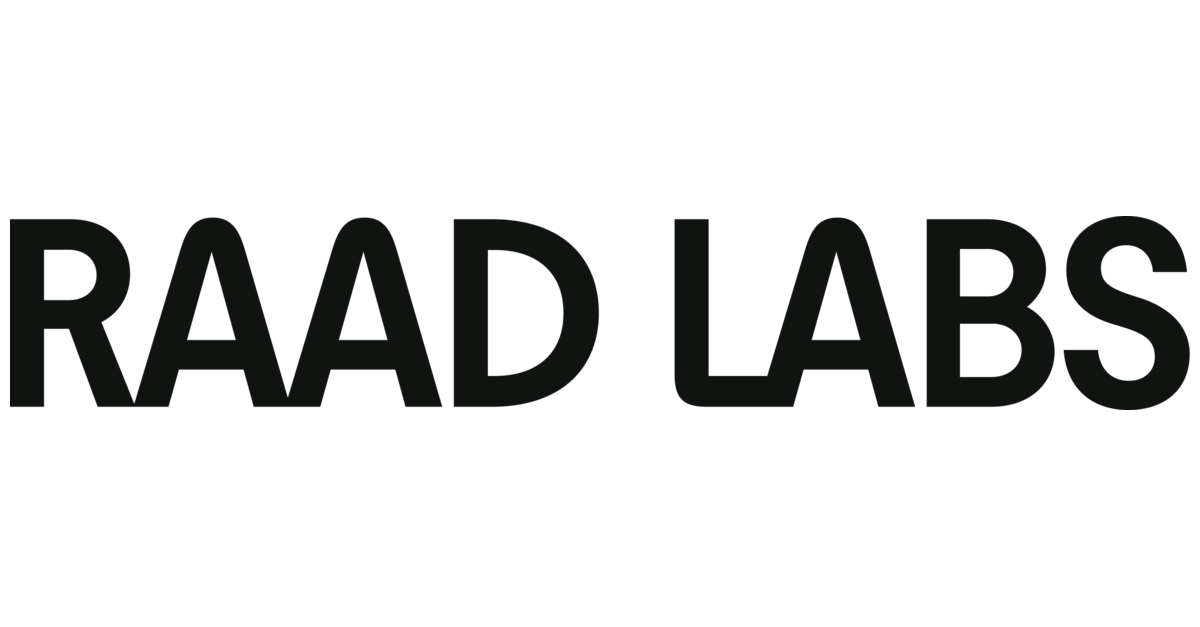Latest DePIN Weather News

2 months ago
Introducing WeatherXM Pro: Revolutionizing Access to Hyperlocal Weather Data
WeatherXM Pro is an innovative weather API platform designed to enhance the demand side of the $WXM economy by providing access to hyperlocal weather data. With a network of over 8,000 weather stations globally, WeatherXM Pro allows users to pull raw data and improve forecasting models. This platform is particularly beneficial for meteorological companies and local communities, especially in underserved regions like Africa and Latin America, where accurate weather data is essential for preparing for extreme weather events. The initiative aims to bridge the gap between on-chain and off-chain data, making weather information more accessible and reliable.
One of the standout features of WeatherXM Pro is its ability to deploy weather stations in areas lacking infrastructure, using strategies like the Cell Bounty program. This program incentivizes users to stake $WXM tokens in specific locations to gather data, thus expanding coverage in regions where demand is high. Additionally, the platform offers Forecast Accuracy Tracking (FACT), which aggregates data from over 40 meteorological models to evaluate their performance against real-world observations. This feature ensures that users receive the most accurate forecasts tailored to their specific locations, enhancing the reliability of weather predictions.
Moreover, WeatherXM Pro integrates on-chain weather data, utilizing specialized hardware that includes cryptographic proofs. This allows the data to be used in prediction markets and weather derivatives, such as parametric weather insurance. The API component of WeatherXM Pro enables developers to easily access and integrate high-quality weather data into their applications, providing tools for monitoring weather trends, historical observations, and forecasts. Overall, WeatherXM Pro represents a significant advancement in the accessibility and accuracy of weather data, catering to various industries and communities worldwide.

3 months ago
WeatherXM's Ambitious Roadmap for 2025
WeatherXM has made significant strides in 2024, achieving key milestones such as the launch of the $WXM token, partnerships with Swissborg, and deploying 2,270 weather stations in the Global South. The deployment of 40 Pulse stations at the Olympics marked another highlight of the year. Despite facing challenges, the launch of WeatherXM Pro stands out as a pivotal achievement, focusing on building the demand side of their tokenomics by selling weather data both on and off-chain. This year, WeatherXM aims to enhance their data offerings and expand their weather station network to support their growing ecosystem.
In 2025, WeatherXM's strategy is twofold: building the demand side through data and expanding the supply side with more weather stations. They plan to establish their weather data as a resolution source for prediction markets like Polymarket and Kalshi, which could unlock weather derivatives and improve weather risk management. Additionally, a partnership with Ensuro for parametric weather insurance is underway, focusing on rain risk management for banana farms in Colombia. The launch of innovative features like Forecast Accuracy Tracking (FACT) and Hyperlocal Station Forecasts (HSF) will provide unprecedented accuracy tracking for weather predictions, catering to industries that rely on precise forecasts.
To further enhance their offerings, WeatherXM is expanding its weather station network, improving technology, and implementing a reward mechanism to encourage high-performing stations. The introduction of the Cell Bounty staking mechanism aims to incentivize community participation in deploying stations in priority areas. With plans for targeted rollouts in regions like South Africa and India, WeatherXM is poised for growth. The upcoming launch of the WS1300 weather station and an industrial-grade model will further solidify their position in the market. Overall, 2025 promises to be an exciting year for WeatherXM as they scale their operations and enhance their data services.

3 months ago
WeatherXM Introduces 'Know Your Station' Feature for Enhanced Weather Data Quality
WeatherXM is set to enhance its mobile app with a new feature called "Know Your Station," aimed at ensuring the proper deployment of weather stations. This feature is part of a series of updates, including Cell forecast, Forecast Accuracy Tracking, and Hyperlocal Station Forecasts, which are designed to improve data quality and user experience. The Know Your Station feature will help users verify that their weather stations are installed correctly from the outset, thereby preventing potential issues that could compromise data integrity and user rewards.
The verification process for Know Your Station is user-friendly and conducted through the WeatherXM Pro mobile app. Upon accessing the feature, users will be greeted with an introductory instructions screen, which may be skipped if the user has previously accepted the terms. Users will then be prompted to submit photographs of their weather station installation from various angles. This process includes guidance through examples of correct and incorrect installations, ensuring users understand the optimal setup before uploading their images for evaluation. This functionality aims to minimize the chances of faulty or misleading weather data by confirming that stations are installed in ideal locations, free from obstructions and securely mounted.
The importance of the Know Your Station feature cannot be overstated, as poorly installed weather stations can lead to inconsistent or inaccurate readings, undermining the overall value of WeatherXM’s data. By providing users with the necessary guidance for proper setup from day one, WeatherXM aims to maintain the reliability of its network, which currently boasts a health rating of 90%. As the Know Your Station feature is set to launch soon, users are encouraged to explore WeatherXM Pro to fully leverage the benefits of accurate weather data in their operations.

4 months ago
WeatherXM: Disrupting the Weather Data Industry in 2025
As we move into 2025, WeatherXM is poised to transform the weather data industry, which has seen significant growth due to increasing demand from various sectors such as agriculture, aviation, and energy. The global market for weather information technologies was valued at approximately USD 9.41 billion in 2019 and is projected to reach USD 17.78 billion by 2027. This growth is fueled by the need for specialized weather services, with companies like The Weather Company and AccuWeather generating substantial revenues. However, the traditional weather data landscape is dominated by government organizations that operate extensive networks of weather stations, which are often costly and limited in deployment capabilities.
WeatherXM aims to disrupt this model by leveraging a more capital-efficient approach to weather station deployment. By utilizing a decentralized network of individual station owners and advanced software, WeatherXM can deploy thousands of weather stations at a fraction of the cost of traditional systems. This innovative model not only enhances the speed of deployment but also allows for the collection of high-quality data from diverse locations. The company has already deployed 7,000 stations in just two years, demonstrating its potential to scale rapidly compared to government-operated networks.
Despite its promising model, WeatherXM faces several challenges, including expanding network size, reaching underserved areas, and capturing the value of its data. The company plans to address these challenges through targeted rollout programs in developing regions, which will enhance weather infrastructure and unlock new economic opportunities. Additionally, WeatherXM is focused on proving the market fit of its data through initiatives like WeatherXM Pro and participation in parametric insurance pilots. As it continues to grow, WeatherXM is well-positioned to provide accessible and reliable weather information, catering to sectors that increasingly rely on accurate weather insights.

5 months ago
WeatherXM Pro: A New Era of Hyperlocal Weather Data
On November 18, 2024, WeatherXM Pro was launched, a cutting-edge platform designed to meet the increasing demand for reliable and hyperlocal weather data. Targeted at developers, researchers, and businesses, WeatherXM Pro provides both historical and real-time weather insights, making it an essential tool for projects requiring high levels of precision and accuracy. The platform is built on a robust network of over 7,100 weather stations worldwide, ensuring that users receive localized data that improves in accuracy over time. The proprietary Quality of Data (QoD) algorithm evaluates the reliability of the data sourced from these stations, ensuring that users can trust the insights they receive for critical decision-making processes.
WeatherXM Pro offers three major features that enhance user experience and data precision. Users can access historical weather data to analyze long-term trends, which is invaluable for climate studies and urban planning. Real-time weather intelligence allows for immediate responsiveness in sectors like logistics and agriculture, where weather conditions can significantly impact operations. Additionally, the platform ensures high-quality, trusted data through rigorous validation processes, making it suitable for industries that require regulatory compliance, such as aviation and construction.
Looking ahead, WeatherXM Pro plans to introduce advanced features such as cell-area forecasts for localized predictions, forecast accuracy tracking to compare third-party forecasts, and AI-powered hyperlocal weather forecasts tailored to specific locations. These enhancements will cater to a wide range of industries, from AgriTech to event management, allowing users to optimize their operations based on precise weather data. With flexible pricing plans, including a free trial and various subscription options, WeatherXM Pro aims to make weather intelligence accessible for all users, reinforcing its position as a vital tool for reliable weather data.

5 months ago
WeatherXM Introduces Solar Obstacle Detection for Reliable Weather Data
WeatherXM is pioneering a decentralized weather station network that allows anyone to contribute weather data from their own stations, earning $WXM rewards in return. This innovative approach raises a critical question: how can users trust the accuracy of data collected from stations set up by strangers? To address this concern, WeatherXM has developed a technology called Solar Obstacle Detection (SOD), which utilizes solar irradiance to verify the quality of the data collected. This method ensures that the stations are properly installed and functioning, providing a reliable source of weather information.
SOD operates by comparing the theoretical solar irradiance curve, which is predictable based on the Earth's movements and the Sun's position, with the actual measurements taken by the WeatherXM stations. This comparison allows the system to detect if a station is oriented correctly, standing vertically, or if it is obstructed by nearby structures. While the concept seems straightforward, real-world complexities, such as geographical features like mountains, can affect solar readings. WeatherXM's team has developed a model that accounts for these factors, enabling accurate predictions of solar irradiance for any given location and time.
The implementation of SOD is set to revolutionize WeatherXM's network by enhancing data quality assessments and optimizing station setups. This technology not only helps identify and penalize poorly installed stations but also rewards those that provide accurate data. Furthermore, SOD will play a crucial role in the Quality of Data (QoD) scoring system, which will be integrated into WeatherXM's reward mechanism. By leveraging blockchain technology, WeatherXM aims to create a trustless environment where users can rely on the data collected, emphasizing that they can trust the Sun as a source of verification.

7 months ago
WeatherXM Ecosystem Updates: Q3 2024 Highlights
In Q3 2024, the WeatherXM ecosystem made significant strides following the successful launch of the $WXM token in Q2. The SwissBorg-Alpha Project, which funded the deployment of 2,270 weather stations in the Global South, kicked off its first installations. Notably, a weather station was set up in Xochimilco, Mexico, documented by local partner SensorETA, showcasing the project's potential to impact communities positively. The team is enthusiastic about the project's future and its capacity to enhance weather data accessibility in underserved regions.
During the Paris Olympics 2024, WeatherXM deployed 40 weather stations as part of a research initiative to analyze weather conditions' effects on athletes. This project aims to develop real-time tools that leverage weather data to optimize athlete performance. Additionally, the introduction of the D1 WiFi station marked a significant upgrade from the previous M5 model, featuring enhanced RF performance, improved GPS capabilities, and stronger security through the new ESP32S3 chip. This upgrade reflects WeatherXM's commitment to advancing meteorological technology.
The team also participated in the Meteorological Tech World Expo in Vienna, where they showcased their innovative products and engaged with industry professionals. The association reported that since the token launch, over 2.5 million $WXM have been awarded to station owners, validating the reward mechanism's effectiveness. Furthermore, $350,000 in onboarding fees were collected for new stations, and plans to increase $WXM liquidity on Uniswap were announced. With a successful commercial data auction and continuous app updates, WeatherXM is poised for further growth and innovation in the coming months.

9 months ago
Blockchain Climate Tech Company Secures Funding for Data Measurement and Forecasting
Raad Labs, a climate tech company, has secured a $2.25 million funding round to enhance climate data measurement and forecasting. The blockchain-enabled network, led by CoinFund and other investors, monitors weather patterns, greenhouse gas emissions, and soil degradation. Raad Labs aims to provide businesses and governments with high-quality data to prevent climate disasters cost-effectively. With the global forecasting market expected to grow, the company's technology has applications in various sectors, including AI and methane detection.

a year ago
Changing Weather Patterns in San Francisco
San Francisco has experienced a noticeable change in its weather patterns over the past few decades, with less summer fog and more turbulent winds. This phenomenon is also observed in Southern California and the Columbia River Gorge. The primary cause of this change is the interaction between the steady cool WSW winds in the Golden Gate area and the warmer, unstable NNW winds above. The topography of Marin County exacerbates this turbulence at Crissy Field near the Golden Gate Bridge. The North Pacific High (NPH), a high-pressure system between Hawaii and the US west coast, is responsible for the NW ocean winds common from March to September. However, in recent years, the NPH has been pushing ridges further into the Pacific Northwest and northern California, causing NNW winds at higher altitudes. The cool, dense air from the NW wind becomes unstable and turbulent when it hits the sun-baked Coast Range, leading to wind shifts, gusts, and lulls. This change in weather patterns is ultimately linked to the warming Arctic.

a year ago
Web3 and Decentralized Networks Offer New Solutions for Climate Monitoring
The climate crisis is a pressing issue that demands innovative solutions. Traditional climate models have limitations, including inaccurate predictions and a lack of real-time data. However, emerging technologies like web3 and decentralized networks offer new possibilities for environmental monitoring. Web3's decentralized approach empowers individuals and communities to take ownership of environmental data, creating a transparent and tamper-proof record. This contrasts with centralized models where data collection is often removed from impacted communities. Decentralized Physical Infrastructure Networks (DePIN) incentivize participants to deploy climate sensors, contributing valuable data and aligning individual and collective interests. While challenges remain, web3 has the potential to revolutionize climate monitoring and response.
Signup for latest DePIN news and updates